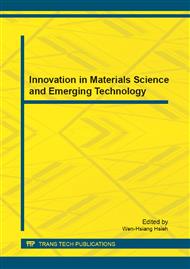[1]
J. Han, and M. Kamber, Data mining: Concepts and Techniques. Second Edition, Morgan Kaufmann Publisher, San Francisco. (2003).
Google Scholar
[2]
P. Frānti, O. Virmajoki, and V. Hautamāki, "Fast Agglomerative Clustering Using a k-Nearest Neighbor Graph, IEEE Trans. on Pattern analysis and Machine Intelligent, vol. 28, no. 11, pp.1875-1881. (2006).
DOI: 10.1109/tpami.2006.227
Google Scholar
[3]
B. Walter, K. Bala, M. Kulkarni, and K. Pingali, Fast Agglomerative Clustering for Rendering, IEEE/EG Symposium on Interactive Ray Tracing, , Los Angeles, California, USA, pp.81-86. ( 2008).
DOI: 10.1109/rt.2008.4634626
Google Scholar
[4]
J. -T. Chien, Decision Tree State Tying Using Cluster Validity Criteria, IEEE Trans. on audio, speech, and Language processing, vol. 13, no. 3, pp.182-193. ( 2005).
DOI: 10.1109/tsa.2004.840941
Google Scholar
[5]
L. A. Zadeh, Fuzzy sets, Information Control, 8, p.338~353. (1965).
Google Scholar
[6]
J.C. Bezdek, A convergence theorem for the fuzzy ISODATA clustering algorithms, IEEE Trans. on Pattern Analysis and Machine Intelligence, pp.1-8. (1980).
DOI: 10.1109/tpami.1980.4766964
Google Scholar
[7]
Z. Pawlak, Rough sets, International Journal of Computer and Information Sciences, 11, 5 , . p.341–356. (1982).
Google Scholar
[8]
P. Maji and S. K. Pal, Rough Set Based Generalized Fuzzy C-Means Algorithm and Quantitative Indices, IEEE Trans. on Systems, Man and Cybernetics, Part B, vol. 37, no. 6, pp.1529-1540. (2007).
DOI: 10.1109/tsmcb.2007.906578
Google Scholar
[9]
G. Peters, Some refinements of rough k-means clustering, Pattern Recognition, 39, pp.1481-1491. (2006).
DOI: 10.1016/j.patcog.2006.02.002
Google Scholar
[10]
H. HAN and M. Mao, Fuzzy-Rough k-Nearest Neighbor Algorithm for Imbalanced Data Sets Learning, International Conference on Fuzzy Systems and Knowledge Discovery, pp.1286-1290. (2010).
DOI: 10.1109/fskd.2010.5569116
Google Scholar
[11]
S. Mitra, W. Pedrycz and B. Barman, Shadowed c-means: Integrating fuzzy and rough clustering, Pattern Recognition, 43, p.431282–1291. (2010).
DOI: 10.1016/j.patcog.2009.09.029
Google Scholar
[12]
R. A. Jarvis and E. A. Patrick, Clustering Using a Similarity Measure Based on Shared Near Neighbors, IEEE Trans. on Computers, vol. C-22, no. 11, pp.1025-1034. (1974).
DOI: 10.1109/t-c.1973.223640
Google Scholar
[13]
Y.Y. Yao, Semantics of Fuzzy Sets in Rough Set Theory, on http: /www2. cs. uregina. ca/~yyao/PAPERS/fuzzy_semantics. pdf.
Google Scholar
[14]
P. Lingras, M. Chen, and D. Miao, Rough Cluster Quality Index Based on Decision Theory, IEEE Trans. on Knowledge and Data Engineering, vol. 21, no. 7, pp.1014-1025. (2009).
DOI: 10.1109/tkde.2008.236
Google Scholar
[15]
P. Lingras, R. Yan, Interval Clustering using Fuzzy and Rough Set Theory, IEEE Annual Meeting of the North American Fuzzy Information, Processing, Society, Banff Alberta, Canada. (2004).
DOI: 10.1109/nafips.2004.1337401
Google Scholar
[16]
J. Komorowski ,L. Polkowski, and A. Skowron, Rough Sets: A Tutorial, on http: /folli. loria. fr/cds/1999/library/pdf/skowron. pdf.
Google Scholar


